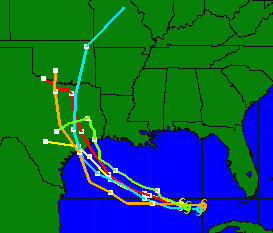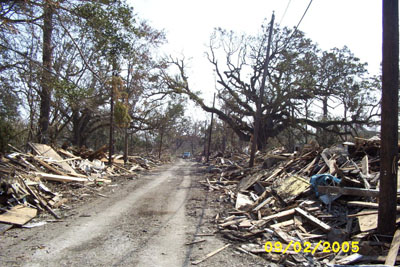Monsters and Saints

Well, this is an interesting turn of events.
Like most anyone who came of age in Chicago in the 80’s I’ve been a Bears fan since their Super Bowl season under Ditka. I’m a fan. Not a die-hard who attends games shirtless in December, but a fan nonetheless.
Which is nothing compared to my wife’s family. Born and mostly raised in New Orleans, they are living caricatures of all-for-the-team dedication. The day I met the men who were to become my father- and brother-in-law — December 28, 1991 — was a Saints playoff game against the Atlanta Falcons — the result of the Saints’ first Division title ever. New Orleans came out strong but ended up blowing it.
I sat in wide-eyed horror as my girlfriend’s brother swore, stomped, threw things, and beseeched God to smite Jerry Glanville (then Atlanta’s coach) with a slow and painful death from cancer. My girlfriend’s father also was disconsolate and enraged, switching from cursing the TV to reprimanding his son not to wish death on anyone. It was a surreal event and one that would repeat itself in style if not in substance during innumerable other football games on which serious money rather than lifelong passion were wagered.
As a long-time Cubs fan I know the perverse pleasure that comes from loving a loser, so I have always respected — if not fully understood — my in-laws’ devotion to the Saints. I have in fact become something of a Saints fan vicariously. But as anyone who knows me or this blog, my heart is with Chicago always. I even mustered some pride when the White Sox won the World Series, I hesitate to type.
So, as Chicago barely squeaked into next week’s confrontation with New Orleans today I received a hug from my son who said “congratulations, Daddy.” I looked at him, looked at my wife shaking her head in anticipation of the inevitable, and said “son, you have one week to make a very serious decision about who you will cheer for next weekend.”
“Oh that’s easy,” he said. “Who dat!?”
City of the dead
I spent Mardi Gras this week in a New Orleans graveyard. For the second time in less than a year, though the first time since Katrina, we said goodbye to a grandparent in the vast city of mausolea called Lakelawn Cemetary. It was so much sadder this time.
Gravediggers know better than most people in New Orleans what rising water can do — which is why most New Orleans cemeteries are above-ground. Row after row of family tombs crowd the landscape like so many midget Roman temples. Last year it seemed novel, if a little macabre, to bear the casket through the alleys of the tombs to my wife’s family plot. The sun was bright. Flowers livened the drab gray houses of the deceased. Flags waved from numerous veterans’ grave sites.
This year the mood of the family was made darker a hundred-fold by the devestated cemetary, a scene very little would need to be modified in for a B-grade horror movie. On this gray day nearly every mausoleum was stained about four feet off the ground with the puke-green demarcation of high water — a grim reminder that most of the bodies of loved ones were submerged during the weeks before the floodwaters receded. If not assisting grave-side ceremonies the reduced cemetery staff (typical wait time for a burial was three weeks post-mortem) were put to work pressure-washing the horizontal bands of slime from the tombs. The grass between the rows was dead, moist, and fetid. It is difficult to say goodbye to someone you love when you are forced to imagine what might have washed out from the soaken caskets in the ooze on the ground.
Around New Orleans people were partying of course. The press made a lot of New Orleans parading on with Mardi Gras despite being so hobbled. But the truth is that the partiers seemed like actors reciting lines, going through the motions. It reminded me of the lone sober person at a party who acts crazier than the drunks in order not to be called out.
Not much has visibly changed since the last time I visited New Orleans. The city is still awash in trash, tarps, and trailers. The question I asked myself this time was: how do you start a city from nothing? Urban areas start slowly, accreting people, services, markets, and social networks over decades and centuries. But what happens when you know you want a city to exist in this spot, right now? What do you start with? Schools? OK, but what will bring the parents back? Business? OK, but who will you sell your wares to? Government? OK, but what if they’re utterly incompetent in the absence of the patronage machine that sustained them? I don’t have an answer. To me, this is less a question of disaster recovery or urban planning than one of human need. What factors begin (or restart) the gravitational pull that sucks in enough matter to create a city?
Yet good spirits persist. We bought a king cake on the way out of town. Running it through the metal detector in the airport the scanner operator said he’d tell us where the baby was in the cake for $5. When he did anyway gratis we thought he was letting us in on an Easter secret. Was the baby always in the green section? Was there some pattern than only true New Orleanians know? The operator chuckled as he said to my wife “Dawlin’, I’m runnin’ a scanna heah. I see ev’ry baby dat comes tru wit da cakes.”
Return to New Orleans
“FEMA, the new four-letter f-word.”
This was one of the signs I encountered minutes after leaving the New Orleans airport on a brief trip to see family this past weekend.
There’s gallows humor about too though. The Times-Picayune was running a FEMA Trailer Holiday Makeover on how to spruce up your temporary domicile despite the circumstances. This of course only applies to the areas with power since you can’t get a FEMA trailer if there’s no power in your area. I was flabbergasted to see how much of New Orleans still lacks this basic utility.
In fact, I was stunned the entire time I was there. From the shockingly understaffed emergency room at East Jefferson General Hospital (another story entirely) to the three-story high mounds of wreckage piled into the medians between boulevards to the patchwork quilt of blue FEMA tarps covering rooftops from Slidell to the bayou, there was so much more still hurting in the area than I — or most of America, I’d bet — realizes. News outlets occasionally check back and there’s the sometime blip on the political radar of Katrina fallout, but for the most part I was unprepared for the degree to which New Orleans is down for the count, seemingly for quite a while.
I had composed a draft of this post before I even arrived in NOLA. I was going to put into words my feeling that Mardi Gras should go ahead full steam this year as a show of the vitality of the city. I’ve scrapped that draft, filed away for some time in the future. New Orleans is not ready. The city is non-functional. Sure the airport is open, but it is ghostly. Only a few gates and a fraction of the concessions are operational. There’s a palpable pall the moment you set foot in the terminal. Driving into the city proper is horrific. Destroyed cars have been towed to the center of I-10, a vast graveyard of corroded metal. The West End, like much of Orleans Parish, is in total ruin. Cryptic FEMA spray-painted symbols adorn every home — and all are abandoned. Doors open, high water mark stains clearly visible, entire neighborhoods are empty. Houses lean and lurch from the foundation damage. Every street intersection — where the traffic lights, if upright, are still not working — is cluttered with makeshift signage for all manner of assistance: tree-shredding, gutting, roofwork, and generic disaster relief services. Yet, basic services are unemployed. (When was the last time you saw a Jiffy Lube offering a signing bonus?) Church steeples point horizontal, straight at the ground still somehow attached, or have impaled parking lots in front of the places of worship. And the trash. By one count there is 34 years worth of rubbish to be hauled away. Junk is literally everywhere, even in the higher-ground neighborhoods relatively untouched by the water.
I arrived and took a cab to my wife’s grandmother’s house where I was to meet my family momentarily who were coming from elsewhere in the city. Entering the neighboorhod I encountered a sign that said “Looters will be shot.” I exited the cab and, without a key, poked around the house for a way into the backyard to wait. I should have known that I would look suspicious. I immediately noticed people mulling about the subdivision looking at me in an unfriendly way. Luckily my wife pulled up shortly, but I am not sure circumstances would have been different if I had loitered longer. I was not prepared for this. I imagined a city on the mend — hobbled for sure, but bound together in a kind of sturdy let’s-get-on-with-it mode. I didn’t see this at all. I’m sure it exists in places, but most of my relatives are depressed and not a few bitter. There’s racial tension in people who have never been disposed to think in those terms. And looting jokes are not funny. This is one case where the news seems not to have covered the worst of it.
Two of my wife’s uncles stayed through the storm. One stayed with his two teenage children, a decision he forcefully admits regretting now. The day after the hurricane when the levees broke he and his kids spent their time moving from house to house shutting off neighbors’ gas lines. At one point my uncle was in the back of the house working with the gas while his children were inside trashing things that would rot from the refrigerator. Suddenly they saw a man through the front windows with a shotgun yell “Hey!” Scared, they ran to get their father’s pistol and headed for the attic. A showdown was averted when the man turned out to be a state trooper from the neighborhood who did not recognize my uncle’s car in the driveway. He was also African-American. Such is the near-tragic misunderstandings that ensue when an every-man-for-himself mentality results from the complete breakdown of law and order.
McDonald’s are shuttered. The Wal-Mart is closed. Yet, drive-through daiquiri bars and po-boy shacks are up and running. The good times will roll again, there’s no doubt. But New Orleans needs time and help and an army of able-bodied workers to get back on its feet. I think Mardi Gras should be celebrated this year. But only for the local residents as a celebration of the living. The city cannot afford the extra police presence, the tonnage of trash, or the degree of lawlessness that normally attends Fat Tuesday and its run-up. New Orleans is no stranger to hangovers, but this time we need to let it recuperate fully before inviting her to party again.
I don’t really mind blizzards
There is a running joke in my family that my brother-in-law is the only person ever to have to evacuate the same hurricane twice. He fled Hurricane Georges in 1998 from Tampa to the safety of relatives in New Orleans. And then had to flee again back to Florida when the storm took aim for the Crescent City.
I’m not sure we’ll joke about this anymore.

Rearranging my wife’s family from Louisiana and Texas to account for Katrina and now Rita is becoming a logistical game of chess with Mother Nature. Five grandparents and six sets of aunts, uncles, and cousins fled Katrina. The cruel irony is that they are all mostly lined up in towns stretching from coastal Texas, to Houston, to Austin — the precise path of Rita. Flooding likely won’t hobble Houston and Austin (though at this rate even inland Austin will be dealing with a category two hurricane), but when power goes out those scorching cities will be very dangerous places to stay. So, the family exodus begins again. Destination Dallas.
Last report is that my sister-in-law and nephew had moved 32 miles out of Houston in 4 hours.
Jobs4Recovery
It is good to drop everything you are working on once in a while, you know? After Katrina hit I was asked to develop a quick employment portal for job-seekers in the states most affected by the disaster. The result, a partnership between IBM and the US Chamber of Commerce, is a search front-end that links into data from Indeed.com and JobCentral.com, plots results via Google Maps, and delivers state-specific secondary resources. This is what happens when you have a smart, talented team to work with.
Need a job? http://www.jobs4recovery.com
Or post one.
Let’s get to work people! There’s much to do.
The destruction of Clermont Harbor
We knew from the aerial shots that Clermont Harbor, home to my grandparents-in-law, was destroyed by the storm surge of Katrina. But certain areas of the image allowed us to hold hope that something survived.
We know this to be untrue now. There is nothing left in Clermont Harbor. Rick at The Chronicles of Jake did my family the great service of taking a detour in his trip to Waveland to photograph my in-laws’ street. The magnitude of the wreckage defies belief, even after the endless parade of gulf coast images in the media has somewhat inoculated me.
We’re fairly certain that this is Forrest Ave. in Clermont Harbor.
Reader Jennifer writes:
My husband and I went on Saturday, 9/3 to salvage what we could and we came away with a garden sign and football. I’m sorry to say that there is not a structure left standing in the community of Clermont Harbor south of the railroad tracks. It is nearly impossible to find anything amidst the rubble.
Special thanks to Rick and Jennifer. (Viva blogosphere!) And thanks to everyone who wrote to offer support. All our relatives are safe. Some of the family from Kenner have already returned, with those from Gretna and Algiers possibly behind them soon. Those who suffered more damage have been relocated to Baton Rouge and Texas.
Clermont Harbor update
We now have aerial photos of Clermont Harbor, home to Robyn’s grandparents. The house is gone, but the railroad embankment to the north seems to have kept the debris contained. The deforestation and the annihilation of mostly cinderblock houses leaves me somewhat speechless.
Before

Google Maps
After

NOAA NOS Data Explorer
Eerily there is less visible damage closer to the beach (not pictured here) because all that remains are the concrete pads of the houses.
It will be months before we get back here to sift through the rubble.
What about the aquarium?
It may sound crass with so much human misery around, but I ask for very human reasons. What is happening at the Aquarium of the Americas? Has it been breached? It is right at Canal St. and the river. There are some creatures in there that you very definitely do not want swimming through the flooded streets of New Orleans. I haven’t heard a word about it.
UPDATE: GC writes in with this story on the aquarium. It survived the hurricane proper, but there appears to be “some question” about its state right now. High water, fire, lawlessness, pestilence … we really don’t need unfed sharks in this equation.
Missing: WeiQun Wang
A colleague of mine in China has not heard from her brother-in-law in New Orleans since Monday morning. If anyone has any information on his whereabouts please contact me.
Name: WeiQun Wang
Date of Birth: 06/13/1968
Last contact time: 08/29 9:30AM
Location: Chemistry lab of Chemistry Department at University of New Orleans
I’m posting this information mostly just to get it indexed and Googleable.
UPDATE: WeiQun has been located and is safe in New Orleans. Phew!
Update from Baton Rouge
Jeff Greer provides a dispatch from the front lines of the medical response to the hurricane.
My parents live in Baton Rouge and were thankfully spared from the brunt of the storm. Most of Baton Rouge has power, but parts of the city are still without and many schools are closed. Phone lines and cellular systems remain congested and it has been difficult to get through.
At this point, BR has become the point of refuge. My father runs a medical clinic there and my mother is a nurse – they are now very much involved in relief efforts. As of last night a few hospitals were still operating in NO, but with the recent orders to evacuate NO things will most likely be changing. BR clinics and hospitals were planning to see as many patients as they could today and LSU has cancelled classes to help accommodate the influx of people who are able to make it there on their own or who have been evacuated from NO. As has been reported, things are incredibly chaotic and without access to working phones, organized communications are nearly impossible.
All facets of infrastructure are at (or have exceeded) their breaking points and I encourage all to donate to charity and/or other support organizations.
For additional information:
Baton Rouge Advocate
NO Times-Picayune














